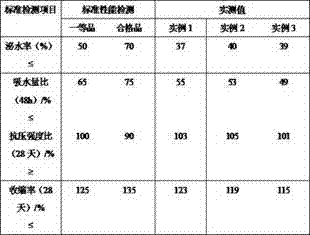Preparation method of waterproof compacting agent for concrete
A waterproof and dense concrete technology, applied in the field of building material additive preparation, can solve the problems of reducing waterproof performance, reducing concrete strength, etc., to achieve the effect of improving strength and waterproofing, enhancing strength and waterproofing performance, and reducing the path of water flow
- Summary
- Abstract
- Description
- Claims
- Application Information
AI Technical Summary
Problems solved by technology
Method used
Image
Examples
example 1
[0019] First weigh 400g of glycine and add it to a beaker containing 800mL of water, then move the beaker into a magnetic stirrer with a digital display constant temperature and speed measurement, stir and dissolve for 20min at a temperature of 70°C and a speed of 350r / min to obtain a glycine solution, take 500mL Add the glycine solution into a three-neck flask with a thermometer and a reflux device, and add a 15% sodium hydroxide solution to the flask to adjust the pH to 10.5, then move the flask into a water bath, and control the temperature of the water bath to 60°C. Add 60mL of epichlorohydrin dropwise to the flask, and control the rate of addition to 5mL / min. After the dropwise addition is completed, heat and stir the reaction for 3 hours. After the reaction is completed, add 10% hydrochloric acid to the flask to adjust the pH of the material in the flask to After 7.5, the product was obtained, and the product was left to separate liquids to obtain the lower layer liquid. ...
example 2
[0021] First weigh 300g of glycine and add it to a beaker containing 700mL of water, then move the beaker into a magnetic stirrer with a digital display constant temperature and speed measurement, stir and dissolve for 15min at a temperature of 60°C and a speed of 300r / min to obtain a glycine solution, take 400mL Add the glycine solution into a three-neck flask with a thermometer and a reflux device, and add a mass fraction of 15% sodium hydroxide solution to the flask to adjust the pH to 10.2, then move the flask into a water bath, and control the temperature of the water bath to 50°C. Add 50mL of epichlorohydrin dropwise to the flask, and control the rate of addition to 3mL / min. After the dropwise addition is completed, heat and stir the reaction for 2 hours. After the reaction is completed, add 10% hydrochloric acid to the flask to adjust the pH of the material in the flask to After 7.3, the product is obtained, and the product is left to separate liquids to obtain the lower...
example 3
[0023]First weigh 350g of glycine and add it to a beaker containing 750mL of water, then move the beaker into a magnetic stirrer with a digital display constant temperature and speed measurement, stir and dissolve for 17min at a temperature of 65°C and a speed of 320r / min to obtain a glycine solution, take 450mL Add the glycine solution into a three-necked flask with a thermometer and a reflux device, and add a mass fraction of 15% sodium hydroxide solution to the flask to adjust the pH to 10.3, then move the flask into a water bath, and control the temperature of the water bath to 55°C. Add 55mL of epichlorohydrin dropwise to the flask, and control the rate of addition to 4mL / min. After the dropwise addition is complete, heat and stir the reaction for 2 hours. After the reaction is completed, add 10% hydrochloric acid to the flask to adjust the pH of the material in the flask to After 7.4, the product was obtained, and the product was left to separate liquids to obtain the low...
PUM
 Login to View More
Login to View More Abstract
Description
Claims
Application Information
 Login to View More
Login to View More - R&D
- Intellectual Property
- Life Sciences
- Materials
- Tech Scout
- Unparalleled Data Quality
- Higher Quality Content
- 60% Fewer Hallucinations
Browse by: Latest US Patents, China's latest patents, Technical Efficacy Thesaurus, Application Domain, Technology Topic, Popular Technical Reports.
© 2025 PatSnap. All rights reserved.Legal|Privacy policy|Modern Slavery Act Transparency Statement|Sitemap|About US| Contact US: help@patsnap.com

